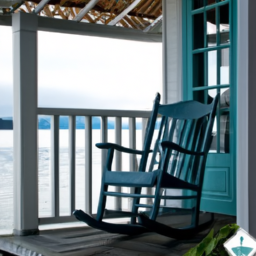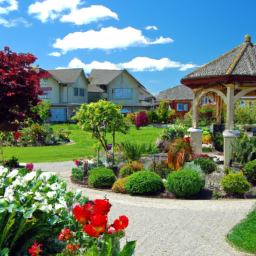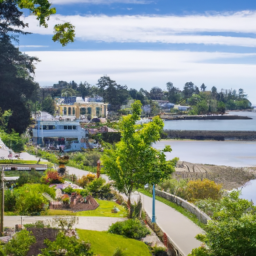
Are you considering retirement in the beautiful Oak Bay area of Victoria, British Columbia? Before making any decisions, it’s essential to have a clear understanding of the retirement living costs in this charming community. From housing expenses to healthcare and leisure activities, this article provides you with valuable insights into the financial aspects of retiring in Oak Bay. So, let’s dive into the details and explore what it takes to live comfortably in this idyllic retirement destination.
Housing Options

1.1 Assisted Living Facilities
Assisted living facilities are a popular housing option for seniors who require some level of assistance with daily activities. These facilities provide a safe and supportive environment for older adults, offering services such as medication management, help with personal care, and 24-hour supervision. Assisted living facilities often have private or semi-private rooms, as well as common areas for socializing and participating in recreational activities. This type of housing option is ideal for seniors who value their independence but may need some assistance with certain tasks.
1.2 Retirement Communities
Retirement communities are specifically designed for older adults who are still active and independent but prefer to live in a community of individuals in a similar stage of life. These communities offer a range of amenities and services, including fitness centers, swimming pools, libraries, and organized social activities. Retirement communities often have a variety of housing options, such as single-family homes, townhouses, or apartments, allowing seniors to choose the type of living arrangement that suits their needs and preferences.
1.3 Seniors Apartments
Seniors apartments, also known as senior housing or senior living apartments, are residential units specifically designed for older adults. These apartments typically provide a safe and secure living environment, with features such as grab bars in the bathrooms and emergency call systems. Seniors apartments may offer a range of amenities, including common dining areas, laundry facilities, and organized social activities. This housing option is suitable for seniors who are self-sufficient and value their privacy but want to live in a community of their peers.
1.4 Independent Living Villages
Independent living villages, also referred to as retirement villages or 55+ communities, are popular among active seniors who desire a low-maintenance lifestyle with a sense of community. These villages often provide a range of amenities such as clubhouse facilities, fitness centers, and landscaped grounds. Independent living villages typically offer various types of housing options, such as single-family homes, condos, or apartments. Residents of independent living villages have the freedom to live independently while enjoying the convenience of on-site services and the opportunity to engage in social activities with fellow residents.
Monthly Rent and Associated Costs

2.1 Assisted Living Facilities
The monthly rent for assisted living facilities can vary depending on factors such as location, size of the living space, and the level of care required by the resident. On average, the monthly cost for assisted living ranges from $3,500 to $6,000. In addition to the rent, assisted living facilities often charge an additional fee for the care services provided. These additional costs typically cover services such as medication management, assistance with activities of daily living, and transportation. It is important to inquire about all potential fees and costs when considering an assisted living facility.
2.2 Retirement Communities
The monthly rent in retirement communities can vary depending on factors such as the location, size of the property, and the amenities provided. On average, the monthly cost for retirement communities ranges from $2,500 to $5,000. This cost usually includes utilities, maintenance, and access to community amenities such as fitness centers and social spaces. Some retirement communities may also offer additional services for an extra fee, such as housekeeping, meal plans, or transportation services. It is important to discuss the specific costs and services included in the monthly rent with the retirement community management.
2.3 Seniors Apartments
The monthly rent for seniors apartments varies depending on factors such as location, size of the unit, and the amenities provided. On average, the monthly cost for seniors apartments ranges from $1,500 to $3,500. The rent typically includes utilities such as water and garbage disposal, but additional costs such as electricity and cable may be the responsibility of the tenant. Seniors apartments may also offer optional services such as housekeeping or meal plans for an extra fee. It is important to inquire about the specific costs and services included in the monthly rent when considering a seniors apartment.
2.4 Independent Living Villages
The monthly rent in independent living villages can vary greatly depending on factors such as location, size of the property, and the amenities provided. On average, the monthly cost for independent living villages ranges from $2,000 to $4,500. This cost usually includes utilities, maintenance, and access to community amenities such as fitness centers, transportation services, and social activities. Some independent living villages may offer additional services for an extra fee, such as housekeeping or meal plans. It is essential to discuss the specific costs and services included in the monthly rent with the management of the independent living village.
Additional Services and Amenities

3.1 Assisted Living Facilities
Assisted living facilities offer a range of additional services and amenities to support the well-being of their residents. These services often include assistance with bathing, dressing, grooming, and medication management. Assisted living facilities also provide meal plans and dining services, ensuring that residents have access to nutritious and balanced meals. Many assisted living facilities organize social and recreational activities, such as group outings, exercise classes, and game nights, to keep seniors engaged and connected with their peers. Transportation services may also be provided to help residents attend medical appointments or run errands.
3.2 Retirement Communities
Retirement communities typically offer a variety of additional services and amenities to enhance the quality of life for their residents. These amenities may include fitness centers, swimming pools, libraries, and common areas for socializing. Many retirement communities provide organized social activities and clubs, allowing residents to engage in hobbies and interests with like-minded individuals. Some retirement communities also offer on-site healthcare services, such as nurse consultations or physical therapy. Transportation services may be available to help residents access off-site medical appointments or other destinations.
3.3 Seniors Apartments
Seniors apartments often provide additional services and amenities to cater to the needs and preferences of their residents. These amenities may include common dining areas, laundry facilities, and communal social spaces. Some seniors apartments offer organized social activities, such as movie nights, book clubs, or exercise classes, to foster a sense of community among residents. Additionally, some seniors apartments may provide optional services such as housekeeping or meal plans for an additional fee. It is important to inquire about the specific services and amenities offered by the seniors apartment when considering this housing option.
3.4 Independent Living Villages
Independent living villages typically offer an array of additional services and amenities designed to promote an active and fulfilling lifestyle for their residents. These amenities may include clubhouse facilities, fitness centers, landscaped grounds, and walking paths. Many independent living villages organize social activities, events, and clubs to foster a sense of community and connection among residents. Some villages may also offer on-site services such as beauty salons, libraries, or hobby rooms. Transportation services may be available to help residents access off-site medical appointments, shopping centers, or other destinations.
Health and Wellness Care
4.1 Assisted Living Facilities
Assisted living facilities prioritize the health and wellness of their residents by providing access to essential care services. These facilities often have trained staff members available 24/7 to assist with medication management, ensuring that residents take their prescribed medications correctly and on time. Assisted living facilities may also have licensed nurses or healthcare professionals on-site to provide routine health monitoring and coordinate medical appointments. In case of an emergency, staff members are trained to respond promptly and appropriately. Residents of assisted living facilities benefit from having healthcare professionals readily available to address their health needs.
4.2 Retirement Communities
While retirement communities are not typically equipped to provide extensive healthcare services, they often offer access to basic health and wellness care. Some retirement communities may have fitness centers or exercise classes to promote physical well-being among residents. Common areas for socializing may also serve as spaces for educational programs or workshops on health topics. Retirement communities may collaborate with healthcare providers to offer on-site services such as nurse consultations or wellness check-ups. Residents can also benefit from the supportive community environment in maintaining their overall health and well-being.
4.3 Seniors Apartments
Seniors apartments do not typically provide on-site healthcare services, but residents can still access necessary health and wellness care through external sources. Many seniors apartments are located in close proximity to healthcare facilities, including hospitals, clinics, and pharmacies. Residents can schedule medical appointments as needed and have easy access to healthcare professionals. Seniors apartments may also offer organized health-related programs or educational events to promote the well-being of residents. It is important for residents of seniors apartments to maintain regular communication with their healthcare providers to ensure their health and wellness needs are met.
4.4 Independent Living Villages
Independent living villages prioritize the health and wellness of their residents by providing access to a range of health-related resources and amenities. These villages often have fitness centers or exercise classes to promote physical well-being among residents. Some villages may offer educational programs or workshops on health topics, providing residents with valuable information and resources. Independent living villages may also collaborate with healthcare providers to offer on-site services such as nurse consultations or wellness check-ups. The supportive community environment in independent living villages encourages residents to prioritize and maintain their overall health.
Transportation Options
Transportation options can play a significant role in the overall quality of life for seniors. It is essential for seniors to have access to safe and reliable transportation to maintain their independence and engage in necessary activities.
Many housing options for seniors offer transportation services to help residents travel to medical appointments, grocery stores, shopping centers, and social events. These transportation services may be provided by the housing facility or coordinated with local transport services. Some housing options also have designated parking spaces or garages for residents who own their own vehicles.
In addition to on-site transportation, seniors may utilize public transportation services such as buses or trains, paratransit services for individuals with disabilities, or rideshare services. It is important for seniors to research and familiarize themselves with the available transportation options in their desired housing location to ensure they can meet their transportation needs.
Dining and Meal Plans
Proper nutrition and enjoyable dining experiences are important aspects of senior living. Many housing options for seniors offer dining services and meal plans to ensure residents have access to healthy and delicious meals without the hassle of cooking.
Assisted living facilities often provide meal plans as part of their overall care services. Residents can enjoy well-balanced meals prepared by professional chefs, catering to their dietary needs and preferences. These facilities may also have communal dining areas, allowing residents to socialize and share meals together.
Retirement communities may offer a variety of dining options, including on-site restaurants, cafes, or bistros. Residents can enjoy a range of menu choices and dining styles, from casual to formal, depending on their preferences. Some retirement communities may offer meal plans as part of the monthly fees, while others may have à la carte options or allow residents to cook in their own private kitchens.
Seniors apartments often provide communal dining areas or shared kitchens for residents to prepare their meals. Some apartments may offer optional meal plans for residents who prefer the convenience of having meals prepared for them.
Independent living villages may have on-site dining venues or restaurants, providing residents with a variety of dining options and experiences. These villages often offer meal plans as part of their monthly fees, ensuring residents have access to nutritious meals without the need for cooking.
Social and Recreational Activities
Social and recreational activities are key components of senior living, promoting socialization, mental stimulation, and overall well-being. Housing options for seniors typically offer a wide range of activities to cater to residents’ diverse interests and preferences.
Assisted living facilities often organize group outings, exercise classes, arts and crafts sessions, and game nights to keep residents engaged and connected with their peers. These facilities may also have common areas such as lounges, libraries, or gardens, providing spaces for residents to socialize and relax.
Retirement communities are known for their extensive social and recreational activities. Residents can participate in fitness classes, educational programs, group trips, and social clubs. Many retirement communities have dedicated activity directors who plan a variety of events and ensure residents have opportunities to engage with others in the community.
Seniors apartments may offer a range of social activities such as movie nights, book clubs, or exercise classes. Communal gathering spaces within the apartment complex provide opportunities for residents to interact and build relationships with their neighbors.
Independent living villages prioritize fostering a sense of community among residents. These villages often offer social activities and events such as lectures, workshops, arts and crafts, or live performances. Residents can join clubs, committees, or special interest groups, allowing them to connect with like-minded individuals and pursue their passions.
Residency Requirements
Each housing option for seniors may have specific residency requirements. These requirements may include age restrictions, income qualifications, or health assessments to ensure the suitability of the housing option for the individual.
Assisted living facilities typically require residents to meet certain criteria related to their care needs. Residents may need to provide medical documentation or undergo an assessment to determine if the facility can adequately meet their needs. Age restrictions are often in place, and residents generally need to be at least 55 years old.
Retirement communities often have age restrictions, with a minimum age requirement ranging from 55 to 62. Some communities may require an interview or review of financial information to ensure residents can afford the monthly fees.
Seniors apartments may have age restrictions, often requiring residents to be at least 55 or 62 years old. Income qualifications may also be considered, especially in subsidized or low-income housing options.
Independent living villages typically have age restrictions, with residents typically needing to be at least 55 years old. Some villages may require potential residents to undergo a health assessment or provide medical documentation to ensure they can live independently within the community.
It is important for individuals interested in senior housing options to inquire about the specific residency requirements of each housing option to ensure they meet the criteria.
Financing and Affordability
The cost of senior housing can vary significantly depending on factors such as location, amenities, and the level of care provided. Financing senior housing options can be challenging for individuals and families, but there are several financial strategies and resources available to help make senior housing more affordable.
Assisted living facilities are often paid for through a combination of private funds, long-term care insurance, and government assistance programs such as Medicaid or Veterans Benefits. Some facilities may offer financial assistance or sliding-scale payment options based on income.
Retirement communities are typically privately funded and require residents to pay monthly fees. These fees can be financed through retirement savings, personal investments, pensions, or other sources of income.
Seniors apartments may offer rent subsidies or be part of government-subsidized housing programs, making them more affordable for seniors on fixed or limited incomes. Applicants for subsidized housing typically need to meet income qualifications and may be subject to waitlists.
Independent living villages are typically privately funded, and residents are responsible for paying monthly fees. Financing options for independent living villages may include retirement savings, personal investments, or the sale of a previous home.
It is essential for individuals interested in senior housing options to explore and understand the various financing options available to determine the most suitable and affordable choice for their specific circumstances.
Benefits and Support Programs
Seniors may be eligible for various benefits and support programs to help cover the costs of senior housing and related expenses.
Government assistance programs such as Medicaid, Supplemental Security Income (SSI), and Veterans Benefits can provide financial support for seniors with low incomes or disabilities. These programs may help cover the cost of assisted living facilities or provide subsidies for seniors living in certain types of housing.
In addition to government programs, there are also nonprofit organizations and foundations that offer financial assistance or scholarships specifically for seniors. These resources can help alleviate the financial burden of senior housing costs.
Additionally, seniors may qualify for tax deductions or credits related to housing expenses, medical expenses, or long-term care insurance premiums. It is advisable to consult with a tax professional or financial advisor to explore potential tax benefits and deductions.
Furthermore, some employers offer retirement benefits or assistance programs that can help offset the cost of senior housing. Retirees should check with their former employers or pensions offices to determine if they are eligible for any financial assistance.
Overall, seniors and their families should research and explore the various benefits and support programs available at the local, state, and national levels to determine if they qualify for financial assistance in covering senior housing costs.






